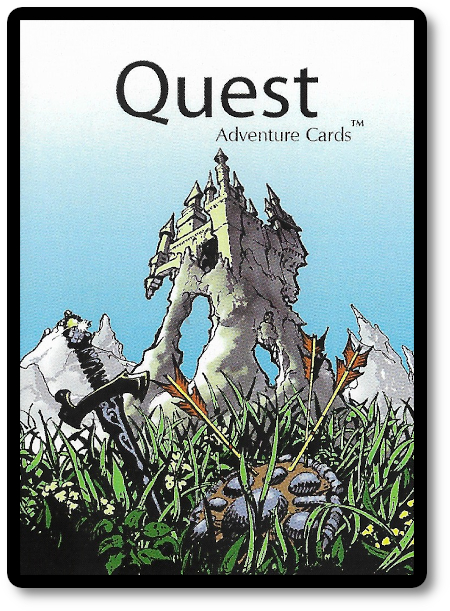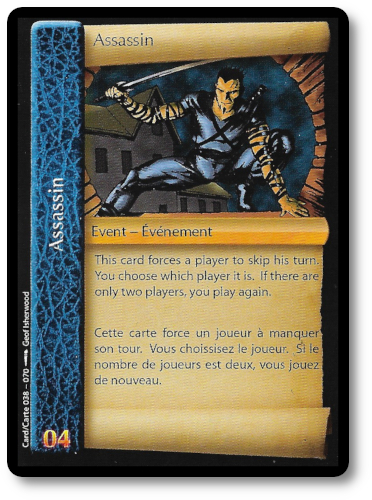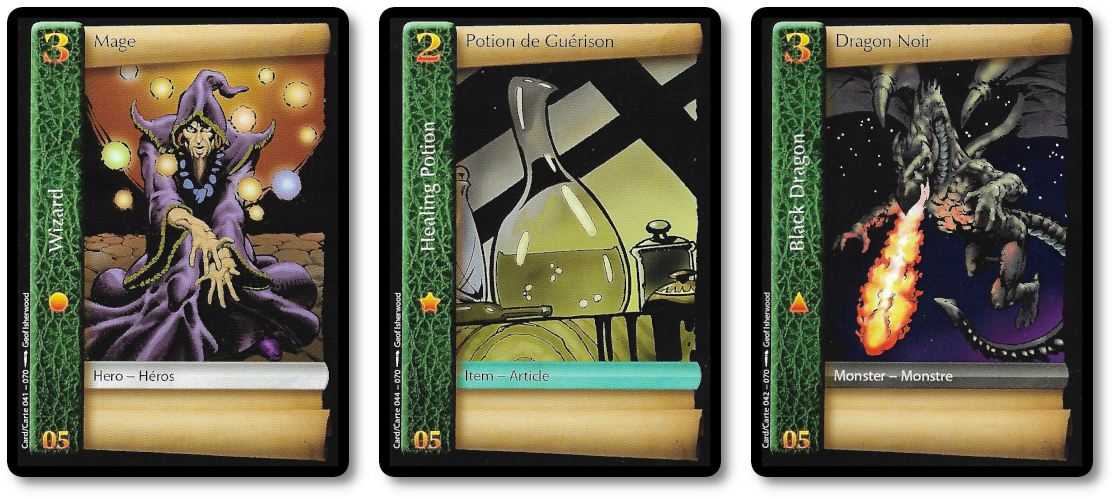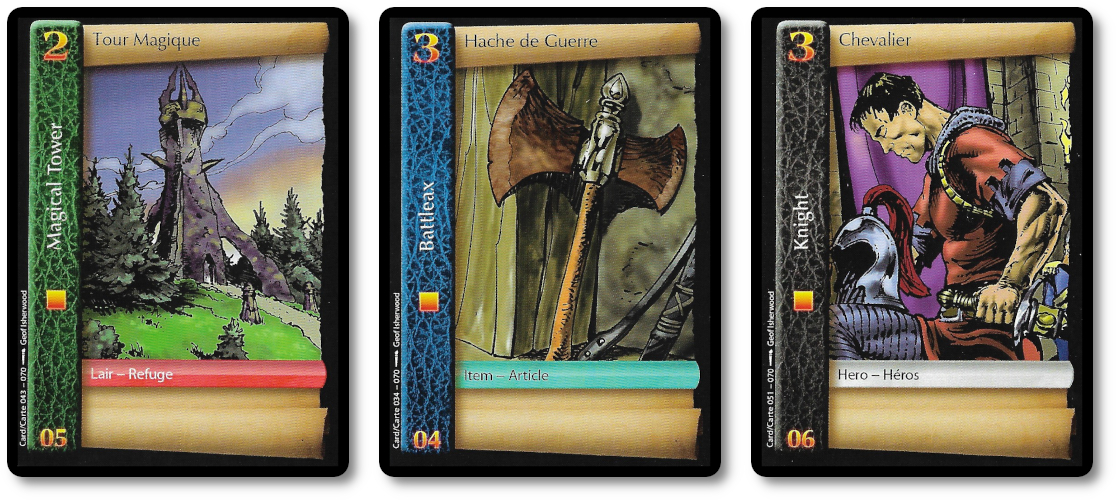 The Basics:
The Basics:
- For ages 9 and up
- For 2 players
- Approximately 15 minutes to complete
Geek Skills:
- Counting & Math
- Pattern/Color Matching
- Hand/Resource Management
- Imagination
Learning Curve:
- Child – Easy
- Adult – Easy
Theme & Narrative:
- Craft an epic fantasy quest and narrative for victory points and fun
Endorsements:
- Child Geek approved!
- Parent Geek mixed!
- Gamer Geek rejected!
Overview
American author and television host Marcus Sakey said, “For me, the best moments in storytelling are the ones where I feel I’m discovering something.” In this game, the epic adventure played out with cards in front of the players is both a record of a journey taken by all the players and the intent of a specific quest of one player. As the game unfolds, more stories are told, some with victories and some with pitfalls. Ultimately, the best stories are those with twists and turns that always lead to adventure.
Quest Adventure Cards, designed by Kristopher R. Kycia and published by Le Groupe Conseil K2 inc., is comprised of 7o cards. All the cards are as thick and as durable as your standard playing card. Illustrations by artist Geoffrey Isherwood are colorful and detailed, providing a fun visual reference to the game’s narrative and theme.
Preparing to Quest
To set up the game for two players, complete the following steps.
First, take all the cards and shuffle them.
Second, deal five cards to each player. Players should look at their cards but keep them hidden from their opponent until played.
Third, place the remaining cards face-down and within easy reach of all the players. This is the draw deck for the duration of the game. Leave room next to the draw deck for a discard pile.
That’s it for game setup! Determine who will go first and begin!
Adventuring We Shall Go!
Quest Adventure Cards is played in turns with no set number of turns per game. A player’s turn is summarized here.
Step One: Draw One Card and Play Cards
The first thing the player does on their turn is draw one card from the draw deck, adding it to their hand.
The player must now decide what cards they want to play. Only three cards may be played during the player’s turn.
Play One Event Card
Event cards provide a unique action that is immediately resolved once played. Read the Event card out loud, complete its instructions, and discard it. Note that if the Event card allows it, the player may play another Event card. Some Event cards may be played out of turn, as well. Refer to the individual Event card for specifics.

Play a New Quest
Play any two cards of the same color but different suits. Quests represent monsters, heroes, items, lairs, and treasure. All the things that make up a great fantasy tale! They are also the only way to score points in the game. For example, the below three cards are all part of a single Quest. Currently, they will provide the player with eight victory points.

Play a New Collection
Play any two cards of different colors but the same suit. Collections allow you to organize and group cards for later play but do not provide victory points.

Play to an Existing Quest or Collection
The player may play up to two cards from their hand to any already played Quests or Collections, including their opponent’s Quests and Collections since some cards reduce the number of victory points.
Step Two: Rearrange Cards (Optional)
Technically, the player may do this at any time during their turn, but I am referring to it as a second step for demonstration purposes.
The player may rearrange any cards already in play by moving a card from a Collection with three or more cards into a Quest with less than all four suits, including their opponent’s.
Players may never transfer cards from a Quest to a Collection.
Step Three: End Turn
When the player has completed their turn, they announce they are finished. If they have more than five cards in their hand, they must discard down to five cards (player’s choice) to the discard pile. However, if the player has fewer than five cards in their hand, they now draw as many cards as needed from the draw deck (one at a time) until their hand size is no more than five.
The next player now takes their turn.
Ending Your Adventures
Points are earned in the game by completing Quests. The Quest is worth the number of victory points noted on the cards. Some cards take away victory points. Cards in Collections do not provide any points during and after the game.
Quests Completed
The first player to score 30 or more points across all of their Quests before the draw deck is depleted wins the game.
If the draw deck is depleted before a player has accumulated 30 or more victory points, the player with the most victory points in their Quests wins the game.
Game Variants
The game described above is for two players. You only need another card deck if you want to play the same game with three or four players.
Additionally, if playing with three or four players, the game can be played with two teams of two players. Teams attempt to be the first to reach 50 victory points across all of their Quests instead of 30.
To learn more about Quest Adventure Cards, visit the game publisher’s website.
Final Word
 The Child Geeks enjoyed the game a great deal, finding the gameplay intuitive and describing their Quests as they played them to the table. This element of storytelling – which is not part of the game – turned out to be the most essential gameplay element to the Child Geeks. According to one such Child Geek, “The game is easy to learn, and I liked playing cards in my Quests and telling my friends the story I was taking my adventurers on. I didn’t mind when others gave me bad Quest cards because it made the story more interesting!” Another Child Geek said, “I know you are supposed to play the game to win, but I never cared much about the points. I just wanted to create cool stories. Counting points at the end of the game seemed dumb because my stories were awesome.” When the last adventurer came home, the Child Geeks all voted and agreed the Quest Adventure Cards was a great time.
The Child Geeks enjoyed the game a great deal, finding the gameplay intuitive and describing their Quests as they played them to the table. This element of storytelling – which is not part of the game – turned out to be the most essential gameplay element to the Child Geeks. According to one such Child Geek, “The game is easy to learn, and I liked playing cards in my Quests and telling my friends the story I was taking my adventurers on. I didn’t mind when others gave me bad Quest cards because it made the story more interesting!” Another Child Geek said, “I know you are supposed to play the game to win, but I never cared much about the points. I just wanted to create cool stories. Counting points at the end of the game seemed dumb because my stories were awesome.” When the last adventurer came home, the Child Geeks all voted and agreed the Quest Adventure Cards was a great time.
 The Parent Geeks found the game entertaining, but only when they played it with the family. The game fell flat when they played it with other adults, and most of the Parent Geeks were uninterested. One Parent Geek said, “I played this game first with my kids and wife. I enjoyed it. We all had a great time. Later, I played it with my friend during lunch, and the game fell flat. I think what you need to enjoy this game is the imagination and excitement only a child can bring to the table.” Another Parent Geek said, “A great game for the family. I want to buy two decks to have more of my kids telling stories simultaneously. It was a lot of fun with the littles, but no stories were told when I played it with other adults. Only card sets to be collected and scored. The game felt less interesting as a result. Playing this game with kids and your family should be mandatory.” When the treasure was found, the Parent Geeks judged its worth and found that Quest Adventure Cards was only an adventure with their kids, giving it a mixed review.
The Parent Geeks found the game entertaining, but only when they played it with the family. The game fell flat when they played it with other adults, and most of the Parent Geeks were uninterested. One Parent Geek said, “I played this game first with my kids and wife. I enjoyed it. We all had a great time. Later, I played it with my friend during lunch, and the game fell flat. I think what you need to enjoy this game is the imagination and excitement only a child can bring to the table.” Another Parent Geek said, “A great game for the family. I want to buy two decks to have more of my kids telling stories simultaneously. It was a lot of fun with the littles, but no stories were told when I played it with other adults. Only card sets to be collected and scored. The game felt less interesting as a result. Playing this game with kids and your family should be mandatory.” When the treasure was found, the Parent Geeks judged its worth and found that Quest Adventure Cards was only an adventure with their kids, giving it a mixed review.
 The Gamer Geeks didn’t care for this game at all. They found it too light, lacking strategy or tactics, and generally uninteresting. According to one Gamer Geek, “I’ve heard others in our groups state that this game is great for families and kids. I believe it. I didn’t find anything entertaining about the game. I liked the artwork and the idea of the game, but the gameplay was dull, and every choice was obvious. You keep this game for the kids, but don’t bring it to the gaming table with your buddies.” Another Gamer Geek said, “This should be marketed as a kid or a family game. No true gamer would appreciate this game at the table. There isn’t much game for anyone looking for deep strategy, interesting tactics, or an engaging narrative. The Child Geeks can keep this game.” When the monsters finished their attack, the Gamer Geeks agreed never to attempt to battle them again, rejecting the game.
The Gamer Geeks didn’t care for this game at all. They found it too light, lacking strategy or tactics, and generally uninteresting. According to one Gamer Geek, “I’ve heard others in our groups state that this game is great for families and kids. I believe it. I didn’t find anything entertaining about the game. I liked the artwork and the idea of the game, but the gameplay was dull, and every choice was obvious. You keep this game for the kids, but don’t bring it to the gaming table with your buddies.” Another Gamer Geek said, “This should be marketed as a kid or a family game. No true gamer would appreciate this game at the table. There isn’t much game for anyone looking for deep strategy, interesting tactics, or an engaging narrative. The Child Geeks can keep this game.” When the monsters finished their attack, the Gamer Geeks agreed never to attempt to battle them again, rejecting the game.
 Quest Adventure Cards is a valid set collecting game with a fantasy theme thrown on top of it. That, in and of itself, will never be enough to entice the gaming elitists, as the Gamer Geeks have clearly stated. However, having the game’s artwork suggest a more robust narrative through creative storytelling made all the difference for the casual and inexperienced player. This was especially apparent when the Child Geeks started telling very involved stories about their heroes based on the adventures (Quests, in this case) they played to the table. Once you see how excited the Child Geeks get and the remarkable stories they tell with the assistance of the images on the cards, you are hooked.
Quest Adventure Cards is a valid set collecting game with a fantasy theme thrown on top of it. That, in and of itself, will never be enough to entice the gaming elitists, as the Gamer Geeks have clearly stated. However, having the game’s artwork suggest a more robust narrative through creative storytelling made all the difference for the casual and inexperienced player. This was especially apparent when the Child Geeks started telling very involved stories about their heroes based on the adventures (Quests, in this case) they played to the table. Once you see how excited the Child Geeks get and the remarkable stories they tell with the assistance of the images on the cards, you are hooked.
But this hook can only catch the families—specifically, families with really creative and vocal Child Geeks. The game briefly engaged with everyone else, and seldom did the players—without the benefit of having a creative Child Geek at the table—suggest they enjoyed the game. It’s a shame as the game allows itself to be easily used as a means of creative discourse that makes many adults smile at the excited voices of our children.
However, a fun game for the Child Geeks is not an excellent match for Parent or Gamer Geeks. This was most certainly the case with Quest Adventure Cards. It’s a fantastic game for those who like to build a story and build off other people’s stories. For everyone else, the game is little more than set collecting. Which, admittedly, is exciting to a limited point and seldom engaging. To that end, I strongly suggest any Parent Geeks who like to play games where storytelling makes it fun – and should be heavily encouraged – to play Quest Adventure Cards as soon as possible. Everyone and anyone else can sit this adventure out.
This game was given to Father Geek as a review copy. Father Geek was not paid, bribed, wined, dined, or threatened in vain hopes of influencing this review. Such is the statuesque and legendary integrity of Father Geek.



